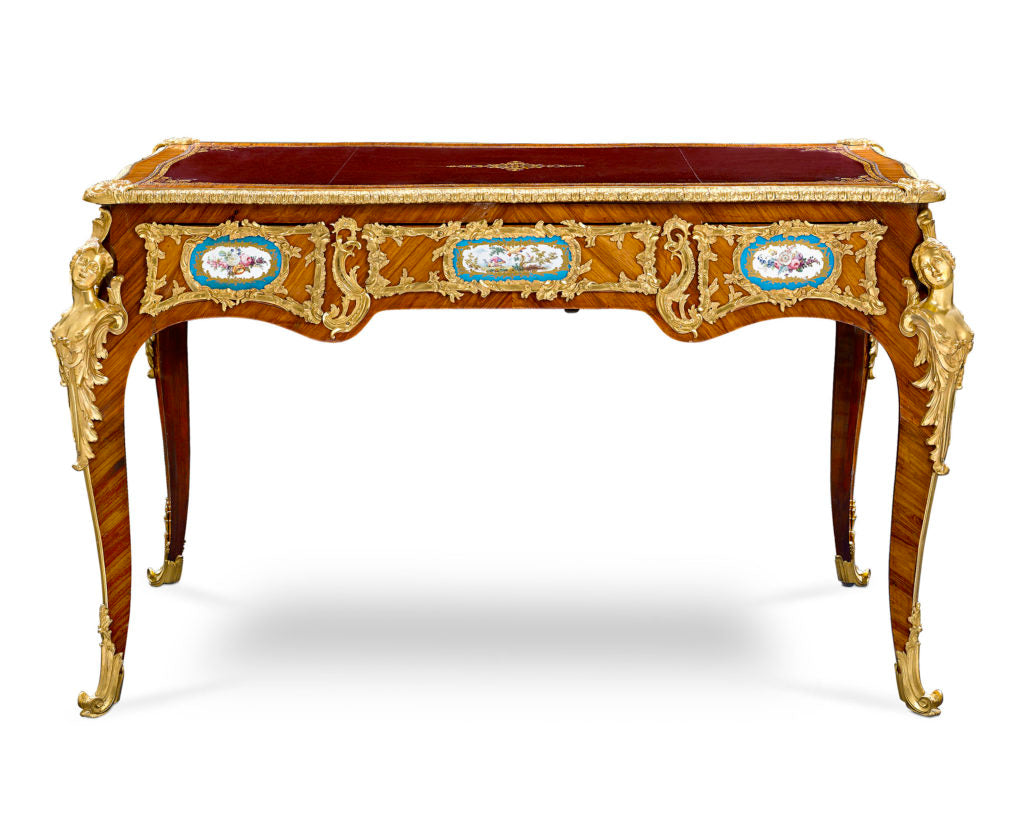shop the item
Long desired by monarchs, emperors, and collectors of influence, the porcelain of Sèvres reflects a timeless legacy of beauty and power. The origins of the factory were modest: it was founded in the 1740’s as a small workshop in Vincennes, France, established to rival major European porcelain producers like Meissen. Within less than two decades, however, the factory evolved into France’s National Manufactory, was acquired by the king, and was relocated to the town of Sèvres.
The first monarch to take a great interest in the porcelain was King Louis XV, whose mistress, Madame de Pompadour, adored the Rococo wares produced in Vincennes. The King became a shareholder of the flourishing enterprise in 1752, and, when an expansion was needed, he suggested a location proximal to Versailles and Paris. The town of Sèvres, on the banks of the Seine, proved to be the perfect location for the factory’s relocation, which occurred in 1756.
shop the item
Despite the porcelain’s popularity, the factory’s operation costs outweighed its income. In order to bankroll such an enterprise, and to please his mistress, the King acquired the entire factory in 1759. Louis XV implemented a variety of tactics to keep his business running including forbidding other porcelain manufacturers to paint in polychrome enamels, to use gold or to create sculptures. He also levied large import duties on porcelain wares from Meissen, Sèvres’ biggest competitor. Annual exhibitions were held at Versailles, at which Europe’s most influential were in attendance and at which the King personally acted as salesman on behalf of the factory!
shop the item
The unprecedented beauty of Sèvres porcelain soon became a source of national pride, although prices remained astronomical due to slow production processes. Sèvres porcelain wares were unrivaled in their vibrant ground colors which included royal blue, crimson, rose (named rose Pompadour, after the King's mistress), apple green, turquoise and mulberry, all accented in flawless hand-painted gilt and enamels. Sèvres cabinet pieces, considered "wonders of the world," were commissioned by kings, dukes, princes and cardinals from around the world.
shop the item
The introduction of hard-paste porcelain in the 1770s brought about major improvements to the factory's production, as it was sturdier and more cost-effective than its soft-paste counterparts. The first hard-paste wares were typically gilt on a white ground, due to difficulties in adhereing soft-paste glaze colors to the hard surface. However, it wasn't long before the innovative designers at Sèvres created a variety of rich hues to decorate their equally impressive hard paste porcelain. Production increased for a decade or so, however the Revolution of 1789 took its toll on the factory. Nonetheless, and against considerable odds, Sèvres has remained in business to the present day.
Shortly after the Revolution and fortunately for the factory, First Consul Napoleon Bonaparte recognized the value of the porcelain as a national treasure and source of pride. He took steps to safeguard the finances of the factory by assuring them a regular governmental income and sometimes even donating money from his own purse. Napoleon appointed Alexandre Brongniart as director of the factory (1800-1847), who in 1804 abolished altogether the output of soft paste porcelain. Under Bronginart’s directorship, the factory received an impressive list of commissions, including various services and pieces for Bonaparte, two dinner services for Tsar Alexander I, pieces for French sovereigns Louis XVIII, Charles X, Louis Philippe and Napoleon III. English monarchs George III and George IV were avid collectors, and their collection, one of the finest of Sèvres porcelain dating back to 1753, remains the property of Queen Elizabeth, housed in Buckingham Palace and Windsor Castle. Numerous other prestigious commissions were made, such as the tea service for the French Military Institute and the tableware made especially for King Louis Philippe's Château de Fontainebleau.
shop the item
Tableware, tea services, decorative cabinets, biscuit statuary, vases, urns, sculpture...the Sèvres factory elevated porcelain’s potential with everything they produced. The factory’s lasting legacy can be experienced at countless major international museums, including, most notably, The Wallace Collection in London, The State Hermitage Museum in Saint Petersburg, and The Metropolitan Museum in New York. For 250 years, Sèvres porcelain has been prized by royalty and nobility, and continues to captivate collectors, art historians, and museum visitors to this day.








